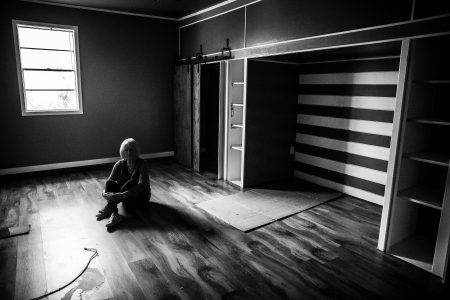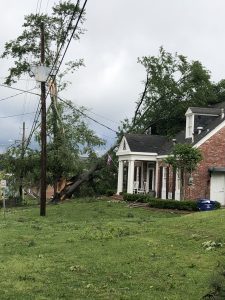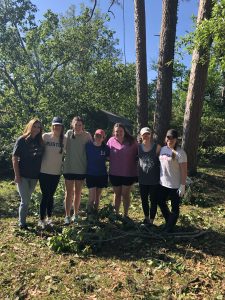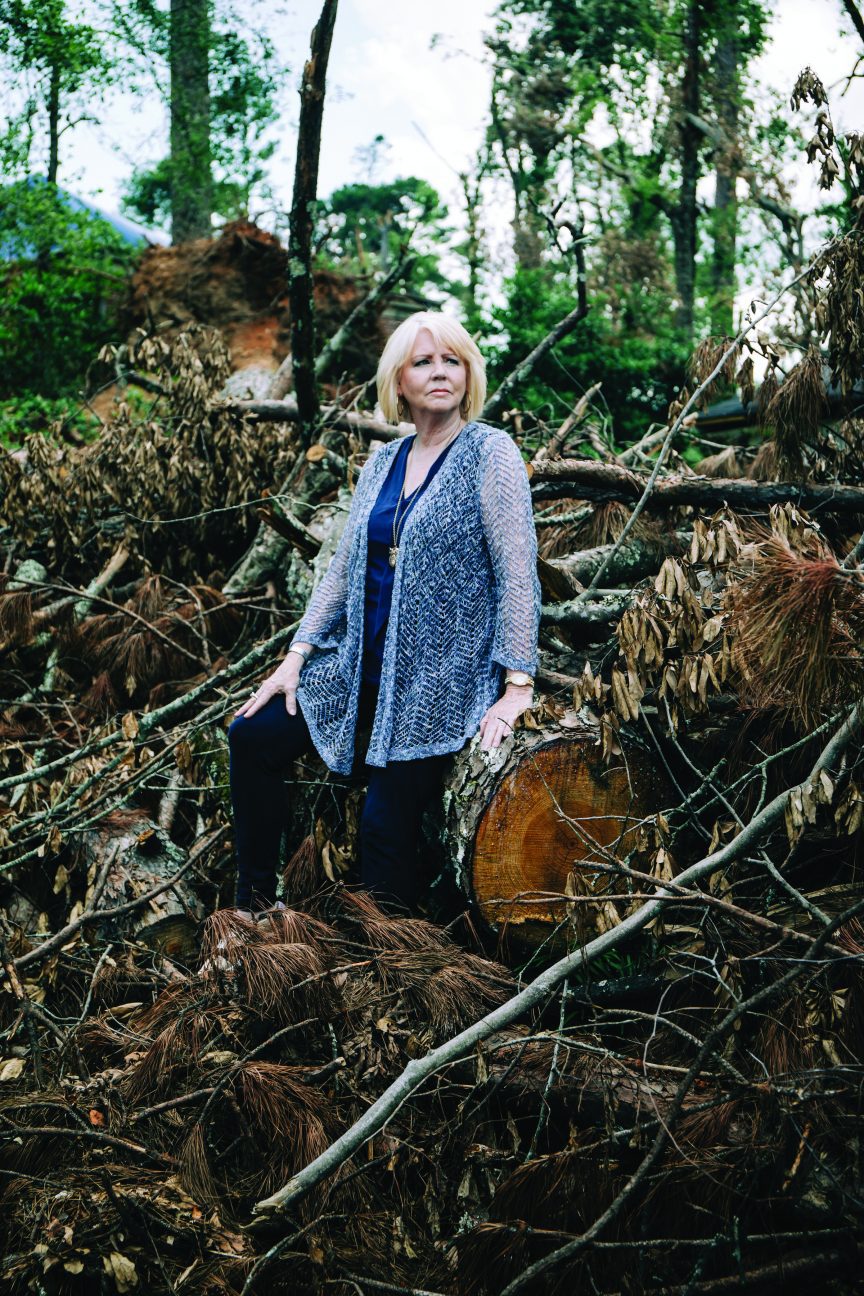Ruston residents went to sleep on the evening of April 24 with no prediction that an F3 tornado would strike during the early hours of the next day.
And like a thief, the storm took its toll: two lives and millions in damages to the city and surrounding areas. Dozens of homes were destroyed and hundreds of others were damaged. Business, too, were also hard hit.
It came like a thief in the night, with little or no warning.
The tornado was a part of was a bigger weather system that moved across the southern United States that week, spawning some eight tornadoes across east Texas and Louisiana, according to the National Weather Service.
The Ruston storm took the lives of 35-year-old Kendra Butler, a Grambling State University student, and her 14-year-old son, Remington Butler, after a tree fell through their home.
Gov. John Bel Edwards declared a state of emergency after he toured the affected area and surveyed the damage caused by the storm in Lincoln Parish, which had winds between 136 mph and 165 mph and traveled nearly seven miles, the NWS Shreveport office reported.
Several neighborhoods were hit, along with Louisiana Tech University. Trained spotters and law enforcement confirmed significant damage to the school’s campus. The university’s core academic buildings were relatively in good shape, but a number of the school’s athletic fields suffered major damage.
Power lines were down throughout a major swath of the city, as well as multitudes of trees, creating safety hazards.
“It looked like a war zone,” said Ruston resident Caty Simmons, who is also the advisory board supervisor for Sigma Kappa sorority on the Tech campus. She made her way to the sorority lodge soon after the storm hit.
The streets were blocked by the downed trees, so Simmons and others passed through a nearby cemetery to get through to their damaged structures. “We saw what were probably 100-year-old trees split in half,” Simmons said.
The whole landscape had changed and will not look the same for some time, a reminder of the storm’s trauma. “Now, if you stand on the front porch, it just looks like a different place,” she said.
It’s changed much more than the landscape for many Ruston residents.
Pam Dance can just now begin to talk about what happened without being overcome with emotion. Despite that her house was totaled by the storm, she feels blessed that it wasn’t worse than it was. “It’s just a miracle,” she said.
 Dance, 66, has lived in the once tree-lined University Hills subdivision for decades. The night of the storm, she was sound asleep, having only gotten home late from her job as a judicial administrator at the district judge’s office.
Dance, 66, has lived in the once tree-lined University Hills subdivision for decades. The night of the storm, she was sound asleep, having only gotten home late from her job as a judicial administrator at the district judge’s office.
“I didn’t hear a phone alarm. I didn’t hear the city’s warning siren,” she said. She went to sleep with her TV on and woke up minutes before the tornado hit to multiple alerts on the local stations to seek shelter.
“They were saying, ‘If you’re in Lincoln Parish, get to a safe place immediately! Immediately!’” she recounted. “They were almost screaming it at me.”
She headed to a room at the other end of the house, Dance said, clutching her tiny Chihuahua, Daisy.
Then it struck.
“It was like someone had a slingshot and trees were being shot through my house,” she recalled.
“Big ol’ limbs … I heard glass breaking … heard the wind whirling around and around,” she said. It did not sound like a freight train, as so many have recounted after other tornadoes.
“I heard the earth shake,” she said, assuming that noise was large trees crashing to the ground all around her house.
She started praying.
“I didn’t know if we were going to make it,” she said, her voice trembling. “I just started praying and praying.”
It lasted about 30 seconds and then it just stopped.
Dance knew she had to get out of the house. And although she didn’t have any shoes on because she had just jumped out of bed to seek shelter, she headed out over all kinds of debris, including broken glass.
Again, another miracle, she said. She suffered no cuts on her feet.
Water was dripping everywhere, as if it was pouring down rain, but it wasn’t raining, she said.
Like so many who act in unexplained ways in an emergency, Dance grabbed a bucket to start catching water falling into the living room.
“My roof was almost gone! What did I think I was protecting?” she laughed.
The only explanation she can offer for the water absent of rain was that a nearby neighbor said tornado had sucked half the water out of his pond. That’s what was falling in her living room, she guessed.
As she and Daisy began to crawl out, she realized the whole neighborhood was thrown into total darkness.
That’s when she called her cousin (Mary Lou Harrison of Calhoun) to come get her.
“I basically had to climb out of there – over trees and a retaining wall,” she said.
 “All I could think about was, ‘I have to get out here – my roof is going to fall on me,’” Dance said.
“All I could think about was, ‘I have to get out here – my roof is going to fall on me,’” Dance said.
“My cousin couldn’t get to me (by car) because all the roads were blocked with trees and downed electrical lines.
“I heard her hollering at me – she didn’t have a flashlight or anything,” she continued. But Harrison wasn’t daunted, Dance said, “and went over the trees and wires. I couldn’t believe it.
“There were miracles up and down that street. I can’t believe no one died in our neighborhood,” she said. Trees fell on one neighbor’s bedroom, and the only thing that stopped it from killing him was the bed’s head board.
“It’s just amazing. I know there were two deaths and that’s so sad, but I’m amazed there weren’t more,” Dance said.
So many things Dance can’t explain.
“What made me wake up? I had just gone to bed and was sound asleep. I didn’t have one cut after walking over that glass. No one even had to go to the local emergency room.”
A lot of help from their friends
Both Simmons and Dance said one positive the storm brought was the overwhelming outpouring of aid so many offered in so many forms.
“People came together,” Simmons said. “We had groups of alumni, almost all of the active chapter members” on hand to help. Several fraternities reached out and helped. Texts and calls poured in with offers of assistance.
“Driving around, you just saw people helping each other. Strangers would ask, ‘You need help?’ and would proceed to jump in where needed. People just dropped everything,” Simmons said.
“It didn’t matter who it was,” she said. “I’ve never seen people come together in that way. Sounds cheesy, but it’s accurate.”
Dance and her son, Jed, experienced the same phenomenal generosity. As they were working on the clean-up, “all these people would show up from churches (asking), ‘What can I do?’”
They came with food, water, chainsaws. “At one time I had six-to-seven people in my back yard with chainsaws, and I only knew two of them. … After one day – 10 hours – my backyard was cleared of limbs. There was kindness galore,” Dance said.
Simmons said people offered help with no expectation of anything in return. “You hope people will do that, but in reality, you don’t see it that often. But that definitely was the case here.”
The generosity was almost overwhelming, Simmons said. “The Tech Foundation allowed us to participate in their Annual Day of Giving. In just 24 hours, we raised almost $15,000 for repairs for our lodge.”
Ruston Mayor Ronny Walker became a bit emotional when he echoed their sentiments about the outpouring.
“This is a very special town,” Walker said. “This tornado showed people what this town is all about.”
The mayor recounted one particular event that illustrated the city’s generosity. “The tornado hit that morning at 1:47,” Walker said. That evening, he was walking through one of the areas that was hit and came to a perfectly clean yard.
He asked the homeowner, “How in the world did you get it so clean? He said 30 college students from Tech came to help.” Walker asked how he was able to organize their coming. The homeowner said he didn’t arrange it – they just came. “They were following the sounds of the chainsaws. They knew if a chainsaw was going, someone was going to need help. That speaks volumes about Louisiana Tech and our city.”
Some FEMA consultants who were in town after the storm were trying to pinpoint what it is that makes the city special, Walker said. They said it’s “the faith of this city and I really believe that’s so true.”
Let the rebuilding begin
 Walker said the city’s main issues were restoring electrical power and removing debris.
Walker said the city’s main issues were restoring electrical power and removing debris.
The city lost 80 percent of its electrical grid. “That was the biggest hurdle,” Walker said. Predictions were that is was going to take 10 to 14 days to restore the power. In actuality, 92 percent was back up in four days, he said.
Another issue that crippled the city was that Ruston lost thousands of trees, which were then cut and piled on the streets.
The National Guard and the city immediately began tackling the problem, but the amount of debris was greater than they could handle. After complying with FEMA bidding requirements, the city secured a company for additional help that came on board in early June. Walker said they hope to be through with debris removal by July.
Repairs have started on the sorority lodge, which sustained more than $25,000 in damage.
“It’s been a process,” Simmons said. “One of the pieces of the puzzle was it took us a long time just to get a tree removal company to the house because of all the roads around it were blocked.”
Once the roof was finished, interior repairs could begin on the damage, which mainly struck the lodge’s living room, the heart of the sorority’s structure.
Dance’s home has been razed and she’s living with her cousin until she can start rebuilding. She was able to salvage a great deal, even though “the house almost fell down around everything.” However, “there were pictures still hanging on the wall … just a miracle.”

